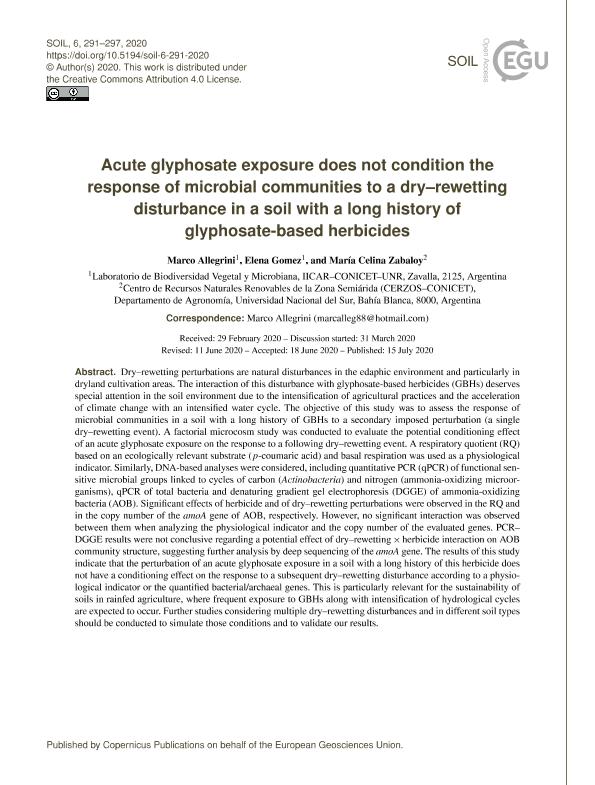Mostrar el registro sencillo del ítem
dc.contributor.author
Allegrini, Marco

dc.contributor.author
Gomez, Elena del Valle

dc.contributor.author
Zabaloy, Maria Celina

dc.date.available
2020-08-05T22:39:18Z
dc.date.issued
2020-07-15
dc.identifier.citation
Allegrini, Marco; Gomez, Elena del Valle; Zabaloy, Maria Celina; Acute glyphosate exposure does not condition the response of microbial communities to a dry-rewetting disturbance in a soil with long history of glyphosate-based herbicides; Copernicus; Soil; 6; 2; 15-7-2020; 291-297
dc.identifier.uri
http://hdl.handle.net/11336/110978
dc.description.abstract
Dry-rewetting perturbations are natural disturbances in the edaphic environment and particularly in dryland cultivation areas. The interaction of this disturbance with glyphosate-based herbicides (GBHs) deserves special attention in the soil environment due to the intensification of agricultural practices and the acceleration of climate change with an intensified water cycle. The objective of this study was to assess the response of microbial communities in a soil with long history of GBHs to a secondary imposed perturbation (a single dry-rewetting event). A factorial microcosm study was conducted to evaluate the potential conditioning effect of an acute glyphosate exposure on the response to a following dry-rewetting event. A Respiratory Quotient (RQ) based on an ecologically relevant substrate (p-coumaric acid) and basal respiration was used as physiological indicator. Similarly, DNA-based analyses were considered, including quantitative PCR (qPCR) of functional sensitive microbial groups linked to cycles of carbon (Actinobacteria) and nitrogen (ammonia-oxidizing microorganisms), qPCR of total bacteria and denaturing gradient gel electrophoresis (DGGE) of ammonia-oxidizing bacteria (AOB). Significant effects of Herbicide and of Dry-rewetting perturbations were observed in the RQ and in the copy number of amoA gene of AOB, respectively. However, no significant interaction was observed between them when analyzing the physiological indicator and the copy number of the evaluated genes. PCR-DGGE results were not conclusive regarding a potential effect of Dry-rewetting × Herbicide interaction on AOB community structure, suggesting further analysis by deep sequencing of amoA gene. The results of this study indicate that the perturbation of an acute glyphosate exposure in a soil with long-history of this herbicide does not have a conditioning effect on the response to a subsequent dry-rewetting disturbance according to a physiological indicator or the quantified bacterial/archaeal genes. This is particularly relevant for the sustainability of soils in rainfed agriculture, where frequent exposure to GBHs along with intensification of hydrological cycles are expected to occur. Further studies considering multiple dry-rewetting disturbances and in different soil types should be conducted to simulate those conditions and to validate our results.
dc.format
application/pdf
dc.language.iso
eng
dc.publisher
Copernicus
dc.rights
info:eu-repo/semantics/openAccess
dc.rights.uri
https://creativecommons.org/licenses/by/2.5/ar/
dc.subject
Acute glyphosate exposure
dc.subject.classification
Ciencias del Suelo

dc.subject.classification
Agricultura, Silvicultura y Pesca

dc.subject.classification
CIENCIAS AGRÍCOLAS

dc.title
Acute glyphosate exposure does not condition the response of microbial communities to a dry-rewetting disturbance in a soil with long history of glyphosate-based herbicides
dc.type
info:eu-repo/semantics/article
dc.type
info:ar-repo/semantics/artículo
dc.type
info:eu-repo/semantics/publishedVersion
dc.date.updated
2020-08-04T19:11:42Z
dc.identifier.eissn
2199-398X
dc.journal.volume
6
dc.journal.number
2
dc.journal.pagination
291-297
dc.journal.pais
Alemania

dc.description.fil
Fil: Allegrini, Marco. Consejo Nacional de Investigaciones Científicas y Técnicas. Centro Científico Tecnológico Conicet - Rosario. Instituto de Investigaciones en Ciencias Agrarias de Rosario. Universidad Nacional de Rosario. Facultad de Ciencias Agrarias. Instituto de Investigaciones en Ciencias Agrarias de Rosario; Argentina
dc.description.fil
Fil: Gomez, Elena del Valle. Consejo Nacional de Investigaciones Científicas y Técnicas. Centro Científico Tecnológico Conicet - Rosario. Instituto de Investigaciones en Ciencias Agrarias de Rosario. Universidad Nacional de Rosario. Facultad de Ciencias Agrarias. Instituto de Investigaciones en Ciencias Agrarias de Rosario; Argentina
dc.description.fil
Fil: Zabaloy, Maria Celina. Consejo Nacional de Investigaciones Científicas y Técnicas. Centro Científico Tecnológico Conicet - Bahía Blanca. Centro de Recursos Naturales Renovables de la Zona Semiárida. Universidad Nacional del Sur. Centro de Recursos Naturales Renovables de la Zona Semiárida; Argentina
dc.journal.title
Soil
dc.relation.alternativeid
info:eu-repo/semantics/altIdentifier/url/https://soil.copernicus.org/articles/6/291/2020/
dc.relation.alternativeid
info:eu-repo/semantics/altIdentifier/doi/http://dx.doi.org/10.5194/soil-6-291-2020
Archivos asociados
